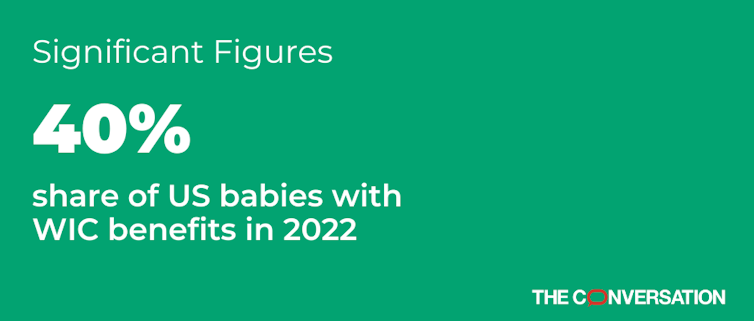2 in 5 US babies benefit from the WIC nutrition program
A monthly average of more than 6 million U.S. women, infants and young children received benefits in 2022 from the nutrition program known as WIC.
The Special Supplemental Nutrition Program for Women, Infants and Children, which is federally funded and state-administered, has served hundreds of millions of American families since its inception in 1974. It provides infant formula, food, nutritional education and health care referrals to low-income pregnant women, the mothers of newborns and very young children and infants and kids up to 5 years old. The government spent about US$5.7 billion on it in 2022.
At its peak, in 2010, the program was helping feed over half of the babies born that year. Participation in the program subsequently declined. About 2 in 5 of the 3.7 million babies born in the U.S. in 2022 benefited from WIC.
Long-term benefits
I am a sociologist who researches food insecurity and participation in the safety net programs that help people get enough to eat. To do this, I analyze nationally representative data from the University of Michigan’s Panel Study of Income Dynamics, which started in 1968 and is the longest-running longitudinal household panel survey in the world. My colleagues and I have used this data to follow the same children from birth through adulthood, observing how their life circumstances change over time.
My research team followed a group of 1,406 individuals from low-income families from birth through ages 20 to 36 years. We looked at reports of food insecurity from their parents during childhood as compared with their own reports of food insecurity as adults living on their own.
We found that food-insecure children who received benefits from WIC and the Supplemental Nutrition Assistance Program, or SNAP, from 1984 to 2019, at anytime from birth to age 17, were four times more likely to report improved food security years later, as young adults, as compared with those who did not receive SNAP or WIC benefits as kids.
We have also found that being food insecure was correlated with having fewer years of formal education and a higher chance of being food insecure in the future.
Personal experience
I have also personally seen how WIC can make a big difference for families.
When I was born in 1985, both of my parents were employed — but we lacked health insurance. My mother found out about WIC through the well-baby clinic in Oakland County, Michigan. While she was on leave from work, my father working two jobs and my older sister still under age 5, the program provided us with health exams, food and additional benefits free of charge.
When my mother returned to her position as a public high school teacher, our needs changed. We no longer needed — or received — the assistance.
The results from the national data study tell my story and the story of many other people: Kids from low-income and potentially food-insecure households can realize a better future with public assistance.
Funding could be interrupted
Millions of Americans depend on public safety net programs, whether for a month or for years. That assistance will be jeopardized should the government shut down if Congress fails to pass a budget before its mid-November 2023 deadline.
Federal WIC funding doesn’t flow during government shutdowns. It “stops immediately when the shutdown occurs,” U.S. Agriculture Secretary Tom Vilsack told reporters in late September.
But county and state governments can make contingency plans to prevent disruption. Minnesota and Massachusetts are among the states doing that.
Even if Congress moves past this budget impasse without a shutdown, the program won’t necessarily be unscathed. House Republicans have been trying to scale it back and in June the House Appropriations Committee passed a measure that would reduce WIC benefits to trim spending. In contrast, legislation in the Senate would instead increase WIC funding in 2024.
Noura Insolera, Assistant Research Scientist, University of Michigan
This article is republished from The Conversation under a Creative Commons license. Read the original article.


